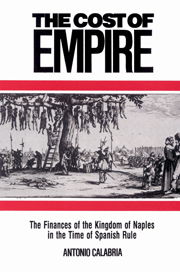Book contents
- Frontmatter
- Contents
- List of figures
- Acknowledgments
- List of abbreviations
- Weights and measures
- Monetary units and exchange rates
- Maps
- Introduction
- 1 The early modern Southern Italian economy
- 2 The fiscal system in early modern Naples
- 3 Government income, 1550–1638
- 4 Government expense, 1550–1638
- 5 The creation of a securities market in the later sixteenth century
- Conclusion
- Appendix I The tables
- Appendix II The sources
- Bibliography
- Index
- Cambridge Studies in Early Modern History
- Frontmatter
- Contents
- List of figures
- Acknowledgments
- List of abbreviations
- Weights and measures
- Monetary units and exchange rates
- Maps
- Introduction
- 1 The early modern Southern Italian economy
- 2 The fiscal system in early modern Naples
- 3 Government income, 1550–1638
- 4 Government expense, 1550–1638
- 5 The creation of a securities market in the later sixteenth century
- Conclusion
- Appendix I The tables
- Appendix II The sources
- Bibliography
- Index
- Cambridge Studies in Early Modern History
Summary
This work has attempted to account for economic, social and fiscal change in the Kingdom of Naples from about 1450 to about 1630. It has shown that from the late sixteenth century onwards, economic, social and political forces worked together to undermine the achievements of fifteenth-century kings. By way of conclusion, it might not be amiss briefly to summarize the major themes in this work and to offer some remarks which the story of Naples in the “long sixteenth century” suggests.
As this work has shown, fiscal pressure came to serve as a powerful destabilizing force in the Kingdom. It diverted large amounts of capital into economically unproductive ventures, into shoring up Imperial power, literally from one end of Europe to the other. But it did so at certain critical points, not at all times in the period of Spanish rule. For most of the sixteenth century, in fact, government receipts in the Kingdom (and no doubt also in much of Europe) struggled barely to keep up with the price movement.
Not only that, but given the geographical imperatives of Italian history and the geo-political context of the Mediterranean in the sixteenth century, there is little question that any administration in Southern Italy – Castilian, Aragonese, Italian, or even, for the sake of argument, Turkish – would have had to devote a substantial amount of resources to war and defense. The fact of the matter was that after the changes begun with, and symbolized by, the invasions of 1494, Italy was a frontier area, as it had been so often in the past, before the Spanish Empire, and as it was to be at other times in the future.
- Type
- Chapter
- Information
- The Cost of EmpireThe Finances of the Kingdom of Naples in the Time of Spanish Rule, pp. 130 - 132Publisher: Cambridge University PressPrint publication year: 1991

